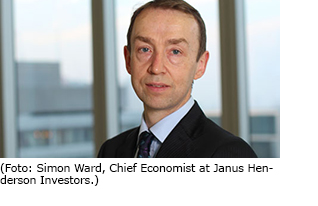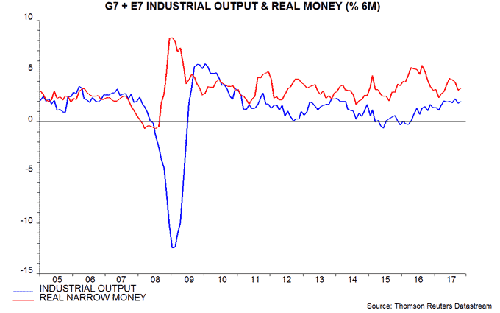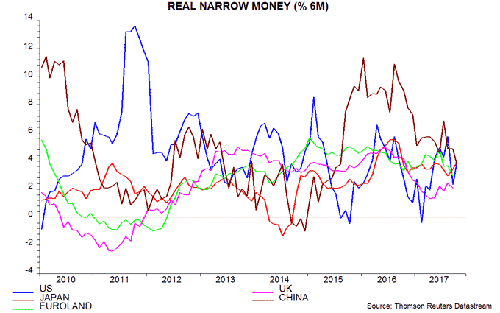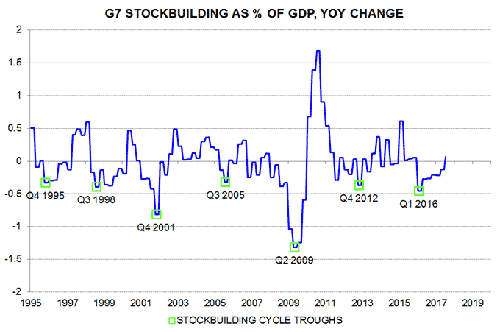
Janus Henderson: Global money trends
Simon looks ahead to next year, suggesting a peak in economic momentum in early 2018, and moderating towards the mid-year. Investors may want to batten down the hatches from that point, moving into 2019.
21.11.2017 | 11:14 Uhr
 Six-month growth of global real narrow money appears to have stabilised in October, following a decline between June and September – see first chart. The rise in real narrow money growth into June was the basis for an earlier forecast here that the global economy would reaccelerate in late 2017. The fall over July-September suggests that economic momentum will peak in early 2018 and moderate towards mid-year. Real narrow money growth remains respectable by historical standards, arguing against significant economic weakness within this time frame.
Six-month growth of global real narrow money appears to have stabilised in October, following a decline between June and September – see first chart. The rise in real narrow money growth into June was the basis for an earlier forecast here that the global economy would reaccelerate in late 2017. The fall over July-September suggests that economic momentum will peak in early 2018 and moderate towards mid-year. Real narrow money growth remains respectable by historical standards, arguing against significant economic weakness within this time frame.

Strong current economic momentum is evidenced by positive data surprises – the Citigroup G10 activity surprise index recently reached its highest level since March – and a surge in upgrades of company earnings forecasts by equity analysts.
The estimated stabilisation of global six-month real narrow money growth in October reflected rises in the US and Japan offset by a further fall in China – second chart. The final estimate will depend importantly on Euroland data to be released on 28 November.

Global real narrow money growth fell significantly between August 2016 and February 2017, contributing to an expectation here that the economy would lose momentum in summer 2017. Economic surprises and earnings revisions turned negative, and G7 government bond yields fell, but GDP / industrial output data remained strong. Why was the monetary signal apparently less powerful on this occasion?
A hypothesis under consideration here is that the significance of changes in monetary trends for future economic activity depends partly on the status of the US / global stockbuilding cycle (the Kitchin cycle). Monetary slowdowns during the upswing phase of this cycle may have muted and / or delayed implications.
The stockbuilding cycle is usually described as having a duration of between three and five years. The judgement here is that cycle troughs occurred in 1995, 1998, 2001, 2005, 2009, 2012 and 2016. The contribution of the change in stockbuilding to the annual rate of change of G7 GDP bottomed in these years – third chart.

Global GDP / industrial output typically accelerates strongly in the year to 18 months after a stockbuilding cycle trough. Monetary slowdowns during this phase may be of less significance for economic prospects than at other times.
This hypothesis is consistent with similar experience after the prior stockbuilding cycle trough in 2012 – global real narrow money growth fell significantly in late 2012 / early 2013 but economic expansion remained strong into early 2014.
The corollary is that economic and market dangers, and the significance of monetary weakness, increase as the stockbuilding cycle matures.
On the dating here, troughs in the stockbuilding cycle since 1995 have been spaced on average 13.5 quarters apart*. Peaks can occur early or late in the cycle but an expectation of a roughly seven quarter spacing from the most recent trough is reasonable in the absence of other information. The judgement that a trough occurred in the first quarter of 2016, therefore, suggests that cycle momentum will start to fade in early 2018.
Major market disturbances in recent decades have usually occurred in the year to 18 months before a stockbuilding cycle trough. Downswings into troughs in 1995, 1998, 2001, 2009, 2012 and 2016 were associated respectively with the Tequila crisis, the Asian crisis / Russian default, the TMT bust, the global financial crisis, the Eurozone crisis and the OPEC / oil price bust. Market conditions remained benign in the run-up to the 2005 trough but this may have contributed to excessive risk-taking and credit expansion in the subsequent upswing.
Based on the average 13.5 quarter spacing since 1995, the next stockbuilding cycle trough could occur in mid-2019, suggesting that investors should batten down the hatches by mid-2018 at the latest – especially if global monetary trends continue to cool.
*Equivalent to 40 months, which equals the average periodicity of cycles in US / UK bank clearings and commodity prices found by Joseph Kitchin in his original 1923 article.



Diesen Beitrag teilen: